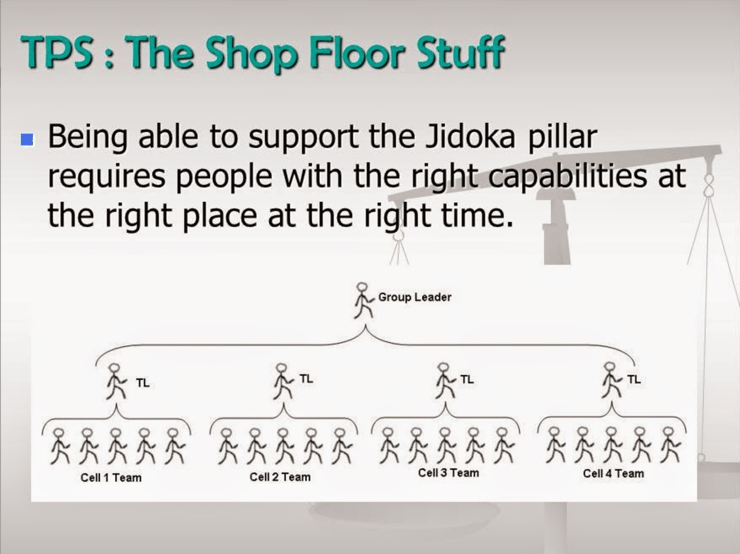










































Recently, I had someone respond that Lean was basically "all that foundation stuff" (5S, Leveling, SW, Kaizen), plus JIT and Jidoka.

When I dug further, asking about their understanding of the concepts just rattled off before me, I got mostly succinct answers until we hit Jidoka.
"What is Jidoka", I asked. "Why is it important"
The response I got was that Jidoka was "And On Cords" and "Poke-Yokes"...oh and "Autonomation". The gentlemen then paused for a moment and added "We have all those things." "
Yes, we do", I replied.
"But how are we USING them...or better yet, ARE we USING them?"
The point I was trying to get across is that just about everyone under the sun by now has a decent textbook understanding of the concepts of JIT and at least partially of Jidoka. But very, very few have the personnel structure in place to properly carry out Jidoka...without it all the other efforts stall, fizz, and fade backwards....and along with it any hopes of forward momentum in exposing new problems.
What you'll see in most businesses is an awful lot of first level employees doing "work" on the product or service the company exchanges for monetary value. Companies spent a lot of time and energy training employee's on "how to do their jobs"....but for the vast majority, that really only includes the functional and administrative portions of their jobs.
What about teaching them how to improve their jobs? How to solve their own problems? Or is that a specialty expertise, reserved for the enlightened CI Specialist or Six Sigma Black Belt?
 Let's back up for a moment and explore some organizations that assume right from the get go, that things will not go as planned....the military.
Let's back up for a moment and explore some organizations that assume right from the get go, that things will not go as planned....the military.
Ever heard the expression:
Both historically and in modern times, the most effective military organizations have been those with decentralized decision and problem solving structures...to quote Wikipedia's article on John Boyd (one of the most amazing strategists and problem solvers of the century) effective organizations use "objective-driven orders, or directive control, rather than method-driven orders in order to harness the mental capacity and creative abilities of individual commanders at each level."
That all sounds wonderful, but how does an organization accomplish this? If you look at the historical make up of military units, you find an interesting parallel between their personnel structure and that of highly effective organizations from other backgrounds.
They work in highly trained, small hierarchical teams that practice solving problems together....A LOT.
For instance, common military unit makeup goes something like this:
 This trend holds pretty true regardless of military unit, division, or nationality to the point that there is rarely more than 10 soldiers to a leader in any situation. There is a leader, and yes they follow orders, but good orders are directional in nature, not specific as to method.
This trend holds pretty true regardless of military unit, division, or nationality to the point that there is rarely more than 10 soldiers to a leader in any situation. There is a leader, and yes they follow orders, but good orders are directional in nature, not specific as to method.
John Boyd hypothesized that all intelligent organisms and organizations undergo a continuous cycle of interaction with their environment. Boyd breaks this cycle down to four interrelated and overlapping processes through which one cycles continuously which he coined the OODA loop.
Of course, while this is taking place, the situation is often changing. Sometimes it's necessary to cancel a planned action in order to meet the new situation one observe.
The teams are responsible for using their training and situational awareness to PROBLEM SOLVE.
Good organizations use the mental capacity of their members in this way. Just as centralized planning is disastrous to national economies, so to is it hurtful to companies.
So what does this have to do with Lean? If you take a good look at a truly "Lean" company...like Toyota, HON, Danahar, etc, you'll find they share this type of structure.

Each leader leads by direction...by establishing "True North" and a set of goals or objectives that drive towards that ideal state, aligned from the highest level so that all are working towards the same mission.
But each is also a teacher and mentor, promoting and developing their subordinates abilities to see and solve problems.
Jidoka, you see, is not just about poka-yokes and and on cords, or even multi machine handling. It's about developing and using people that embody the OODA or PDCA mindset.
(Toyota uses the PDCA, or Deming Cycle, but there's more similarities between that and Boyd's cycle then there are differences).
In order to do that however, you can't assign 30-40 people to a single leader...people need coaching and mentoring; someone not to provide the answers...but to ask the right questions.
View our schedule of industry leading free to attend virtual conferences. Each a premier gathering of industry thought leaders and experts sharing key solutions to current challenges.
View Schedule of Events-------------------------------------------------------
Search for anything
Insights from the most progressive thought leaders delivered to your inbox.
Insights from the world's foremost thought leaders delivered to your inbox.
Being a hero is all about creating value for others. Please invite up to 5 people in your network to attend this premier virtual conference, and they will receive an invitation to attend.
If it’s easier for you, please enter your email address below, and click the button, and we will send you the invitation email that you can forward to relevant people in your network.
View our schedule of industry leading free to attend virtual conferences. Each a premier gathering of industry thought leaders and experts sharing key solutions to current challenges.
View Schedule of EventsWatch On-Demand Recording - Access all sessions from progressive thought leaders free of charge from our industry leading virtual conferences.
Watch On-Demand Recordings For FreeDelivered by the industry's most progressive thought leaders from the world's top brands. Start learning today!
View All Courses NowThe premier Business Transformation & Operational Excellence Conference. Watch sessions on-demand for free. Use code: BFH1120
Watch On-DemandInsights from the most progressive thought leaders delivered to your inbox.
Insights from the world's foremost thought leaders delivered to your inbox.
Being a hero is all about creating value for others. Please invite up to 5 people in your network to also access our newsletter. They will receive an invitation and an option to subscribe.
If it’s easier for you, please enter your email address below, and click the button, and we will send you the invitation email that you can forward to relevant people in your network.
Courtesy of Nintex Pty's Paul Hsu, below is a transcript of his speaking session on 'Improve employee productivity during and post-COVID by ...
Read this article about HP, Best Achievement in Operational Excellence to deliver Digital Transformation, selected by the independent judging panel, ...
Read this article about BMO Financial Group, one of our finalists, in the category Best Achievement in Operational Excellence to deliver Digital ...
Read this article about Cisco, one of our finalists, in the category Best Achievement of Operational Excellence in Internet, Education, Media & ...









































































































































































































